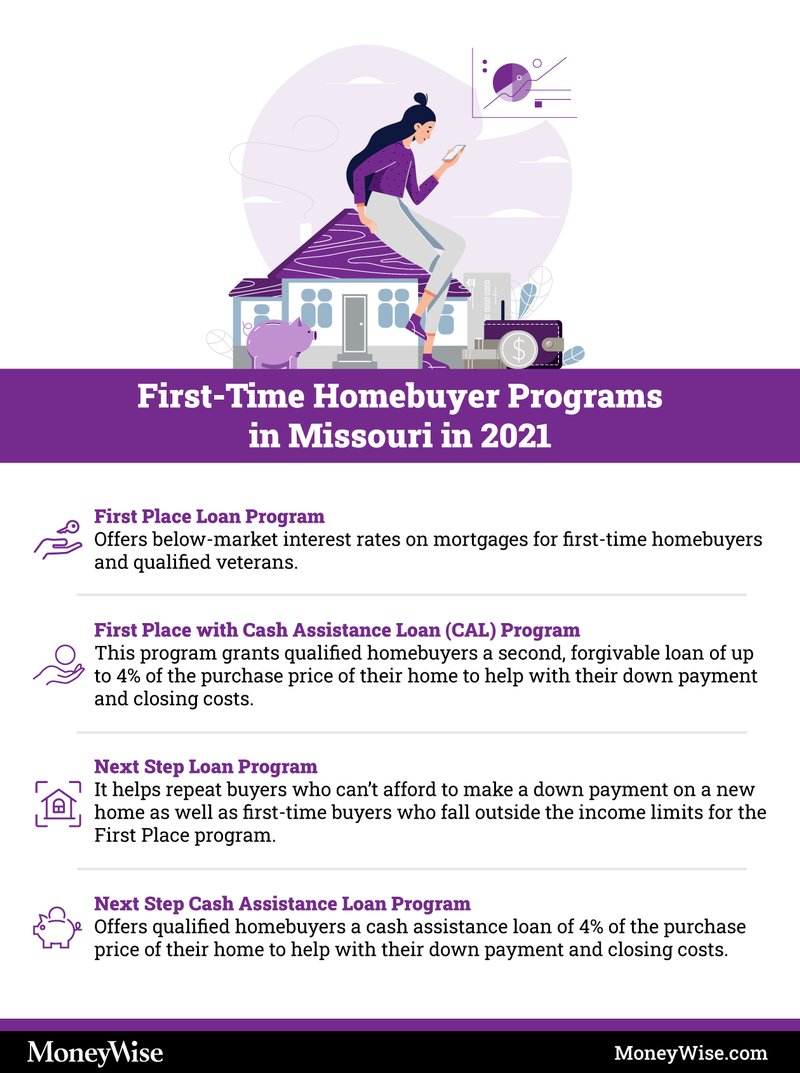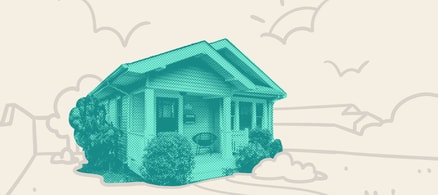First-time home buyer programs in Missouri
MHDC works with a list of approved lenders to run its homebuyer programs.
Some of those programs have different requirements if you’re buying in a targeted area of Missouri.
First Place Loan Program
The First Place Loan Program offers below-market interest rates on mortgages for first-time homebuyers and qualified veterans.
MHDC defines a first-time buyer as someone who has not owned or had a principal interest in a home in the last three years. Qualified veterans include any veterans who have served on active duty, though they must apply for financing within 25 years of the date they left active duty.
The commission sets the interest rates for all of its lenders, as well as how much they can charge you on closing costs, meaning everyone has access to the same rates. You can find the MHDC’s purchase price and income limits on its website.
Since this program doesn’t offer help on down payment and closing costs, it’s best suited for individuals who can afford those costs on their own.
The income limits for this program vary by region.
The purchase price limit depends on the type of home and whether it’s located in a targeted area of the state. In non-targeted areas, you can obtain a maximum of $294,600 for a single-unit property and $377,219 for a two-unit property. In targeted areas, that goes up to $360,067 for single units and $461,046 for two units.
Candidates will also have to meet the credit score requirements and make the home their primary residence within 60 days of closing.
More: Income based mortgage calculator
First Place with Cash Assistance Loan (CAL) Program
In addition to the primary First Place loan, this program grants qualified homebuyers a second, forgivable loan of up to 4% of the purchase price of their home to help with their down payment and closing costs.
The loan works as a second mortgage on a 30-year fixed-rate term, but it will be forgiven after 10 years, provided you keep the property as your primary residence. It can be applied with conventional, FHA, VA and USDA mortgages.
Next Step Loan Program
The Next Step program helps repeat buyers who can’t afford to make a down payment on a new home as well as first-time buyers who fall outside the income limits for the First Place program.
Working with a qualified lender, Missouri homebuyers can qualify for a 30-year fixed-rate mortgage at a competitive rate. It’s compatible with conventional, FHA, VA and USDA loans, and you’ll have the option of applying for upfront cash assistance and a mortgage credit certificate.
The income limits for this program vary by region across Missouri. Applicants will also have to meet the credit score requirements and make the home their primary residence within 60 days of closing.
The Mortgage Underwriting Process Explained
A walkthrough of proven steps to getting a mortgage approval.
See GuideNext Step Cash Assistance Loan Program
The Next Step CAL program offers qualified homebuyers a cash assistance loan of 4% of the purchase price of their home to help with their down payment and closing costs.
Like the First Place CAL, this will be a second mortgage on a 30-year fixed-rate term. After 10 years, provided you keep the property as your primary residence, the loan will be forgiven. It can be used with conventional, FHA, VA and USDA first loans.
First-time homebuyers may also combine Next Step with MHDC’s Mortgage Credit Certificate program, provided they meet the requirements.
Mortgage Credit Certificate (MCC)
An MCC offers you a dollar-for-dollar credit on your federal taxes for the interest you pay on your mortgage loan. It can only be issued through MHDC’s participating lenders and is typically only available to low- to moderate-income borrowers.
On its own, the MCC is worth 25% off your annual mortgage interest, but you can combine it with the Next Step CAL Program to bring that up to 35% or the Next Step without CAL to qualify for 45%. The maximum allowable credit each year totals $2,000, but you can carry forward any unused portion of the credit for up to three years.
This program is reserved for first-time homebuyers, and you’ll have to apply for it through one of MHDC’s participating lenders. To qualify, you’ll have to fall under certain income and purchase price limits and meet MHDC’s credit score requirements.
Find a Lender
Compare RatesStop overpaying for home insurance
Home insurance is an essential expense – one that can often be pricey. You can lower your monthly recurring expenses by finding a more economical alternative for home insurance.
SmartFinancial can help you do just that. SmartFinancial’s online marketplace of vetted home insurance providers allows you to quickly shop around for rates from the country’s top insurance companies, and ensure you’re paying the lowest price possible for your home insurance.
Explore better ratesWho qualifies for Missouri first-time home-buyer programs?
The Missouri Housing Development Commission offers some homebuyers in the state a leg up with affordable interest rates and payment assistance programs.
Its First Place programs are targeted at first-time homebuyers and qualified veterans, while Next Step helps buyers who don’t have the funds to cover their closing costs and first-timers who don’t meet the First Place requirements.
Depending on the program, MHDC sets regional income and purchase price limits. You’ll also have to meet the credit score requirements for your loan type, which typically ranges from 580 to 620.
Nationwide first-time homebuyer programs
The most common way to buy a home is to find a “conventional mortgage” through the private market. They often have low interest rates but high requirements, including a credit score of at least 620 and a typical minimum down payment of 5%.
Many first-time buyers will find one of the following nonconventional options, run by the federal government, a better fit.
FHA loans
Back in 1934, most Americans were still renting their homes. To encourage more renters to become homeowners, the Federal Housing Administration created FHA loans.
The requirements for FHA loans are a bit looser than they are for conventional mortgages. You can get away with a credit score of just 580, and with a big enough down payment, you could go as low as 500. The minimum down payment is 3.5%, but you’ll have to pay extra for mortgage insurance if you put down less than 10%.
The FHA's Loan Requirements Explained.
A walkthrough of how to meet the FHA's requirements.
See GuideVA loans
Congress passed an act in 1944 to grant more benefits to veterans, including easier access to homeownership. From that act, VA loans were created. Since then, the U.S. Department of Veterans Affairs (VA) can guarantee or insure home, farm and business loans made to veterans by lending institutions.
Access to these loans is limited to active service members, veterans or surviving military spouses. VA loans have a very low barrier to entry because they don’t require a down payment or mortgage insurance; however, they do have a significant funding fee.
USDA loans
For lower-income rural and suburban Americans, USDA loans are a great option. They’re guaranteed by the United States Department of Agriculture and, like VA loans, don’t require a down payment or mortgage insurance.
One trade-off with a USDA loan is that you’ll have to pay an upfront 1% guarantee fee and an annual 0.35% fee of your total loan amount. But compared to the mortgage insurance costs associated with other types of loans, you’re likely to come out ahead.
Bear in mind these loans are specifically for lower-income households. The current income limits in most parts of the U.S. are $86,850 for one- to four-member households and $114,650 for five- to eight-member households, though the thresholds may be higher if you live in a county with a high cost of living. You can find your region’s limit on the USDA’s website.
Need cash? Tap into your home equity
As home prices have increased, the average homeowner is sitting on a record amount of home equity. Savvy homeowners are tapping into their equity to consolidate debt, pay for home improvements, or tackle unexpected expenses. Rocket Mortgage, the nation's largest mortgage lender, offers competitive rates and expert guidance.
Get StartedNext steps
With all the information laid out in front of you, it may not be clear where you should start.
A great first move would be to take a look at your credit score and see how you measure up to your ideal loan’s requirements. You can get a free score through the site Credit Sesame.
Was your score disappointing? That’s OK; you have plenty of options. An organization like Self credit repair can help you bring your score up.
When you’re in good shape, don’t forget to gather the important documents you’ll need to prove you’ve got money in the bank and money floating in.
Then you can finally think about getting pre-approved for a mortgage and start shopping for your new digs.
| Arizona | |
| Arkansas | |
| California | |
| Colorado | |
| Connecticut | |
| Delaware | |
| Florida | |
| Georgia | |
| Hawaii | |
| Idaho | |
| Illinois | |
| Indiana | |
| Iowa | |
| Kansas | |
| Kentucky | |
| Louisiana | |
| Massachusetts | |
| Michigan | |
| Minnesota | |
| Missouri | |
| Montana | |
| Nebraska | |
| Nevada | |
| New Mexico | |
| New York | |
| North Carolina | |
| Ohio | |
| Oklahoma | |
| Oregon | |
| Pennsylvania | |
| South Dakota | |
| Tennessee | |
| Texas | |
| Utah | |
| Virginia | |
| Washington | |
| Wisconsin | |
| Wyoming |
When you’re in good shape, don’t forget to gather the important documents you’ll need to prove you’ve got money in the bank and money floating in.
Then you can finally think about getting pre-approved for a mortgage and start shopping for your new digs.
Sponsored
Follow These Steps if you Want to Retire Early
Secure your financial future with a tailored plan to maximize investments, navigate taxes, and retire comfortably.
Zoe Financial is an online platform that can match you with a network of vetted fiduciary advisors who are evaluated based on their credentials, education, experience, and pricing. The best part? - there is no fee to find an advisor.









